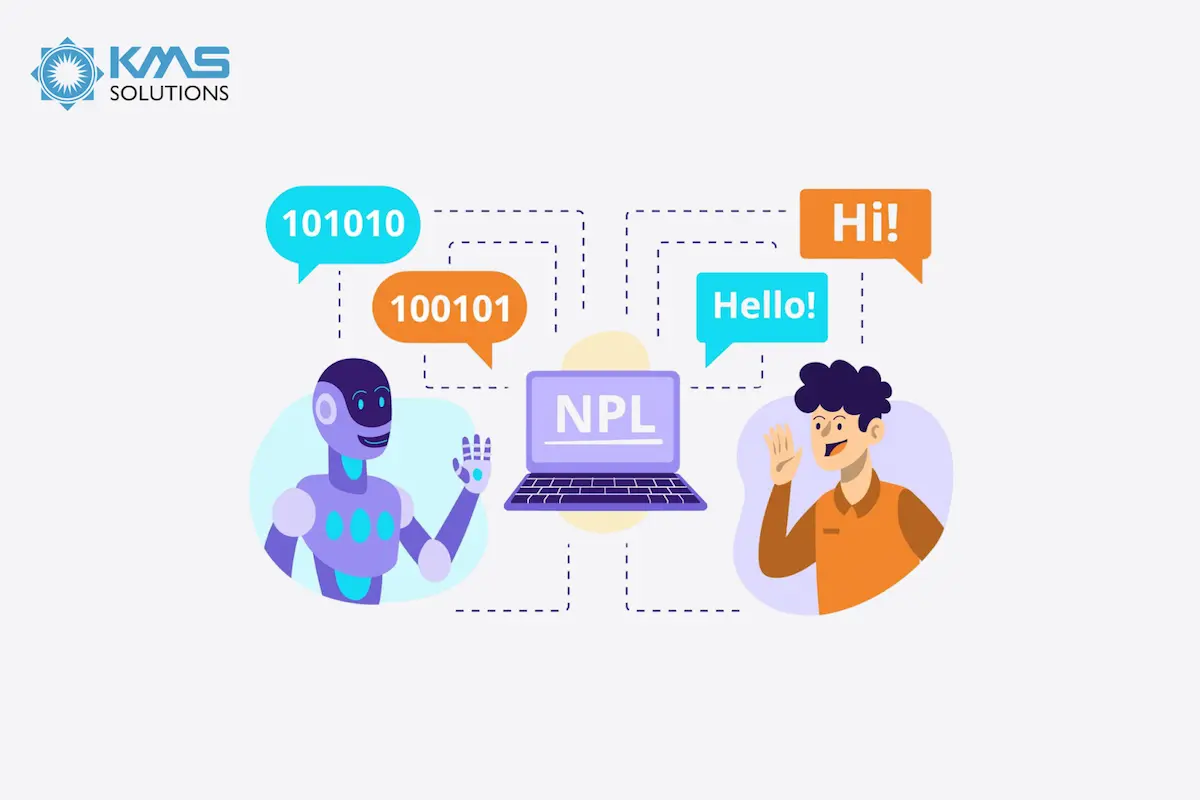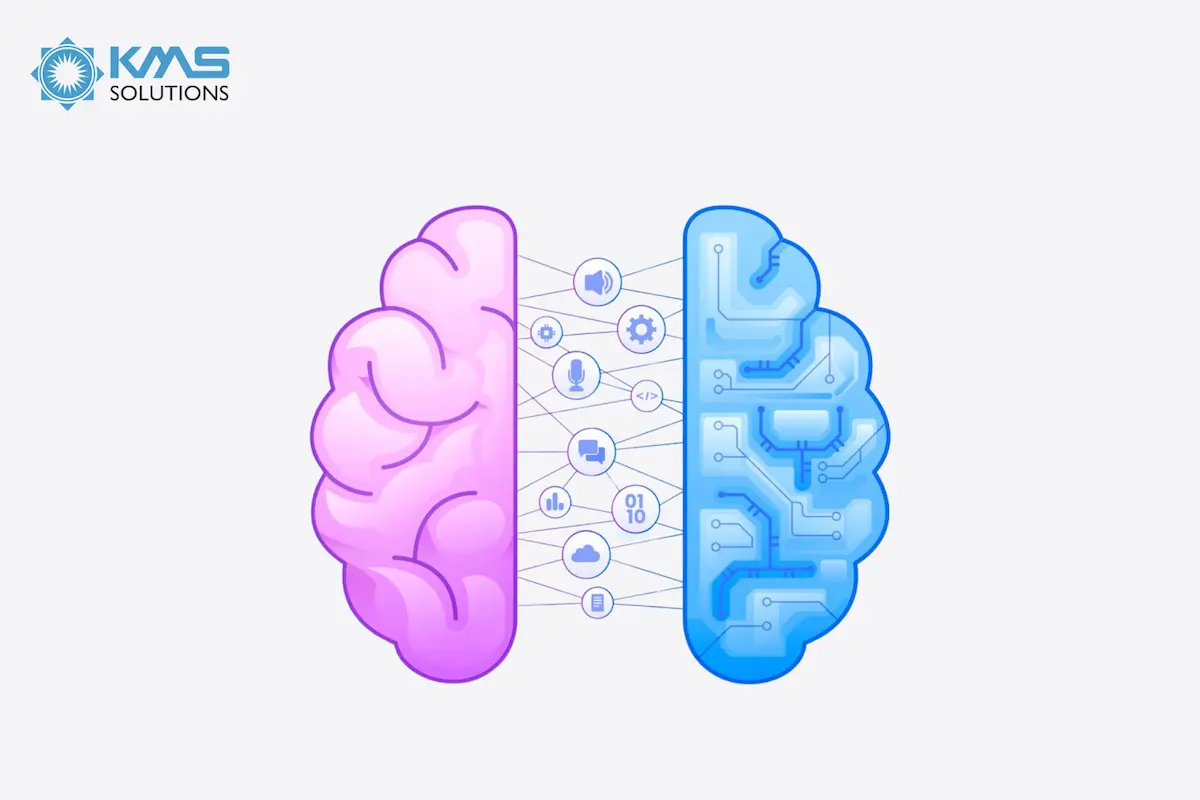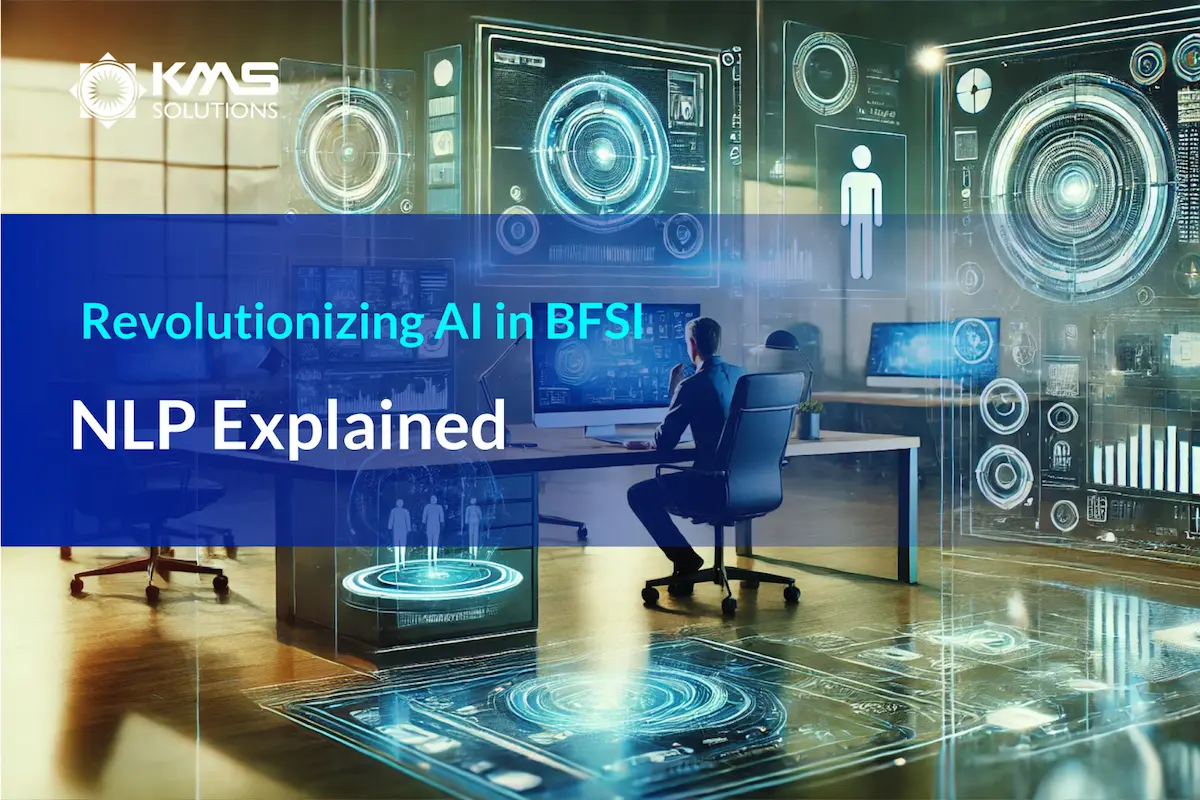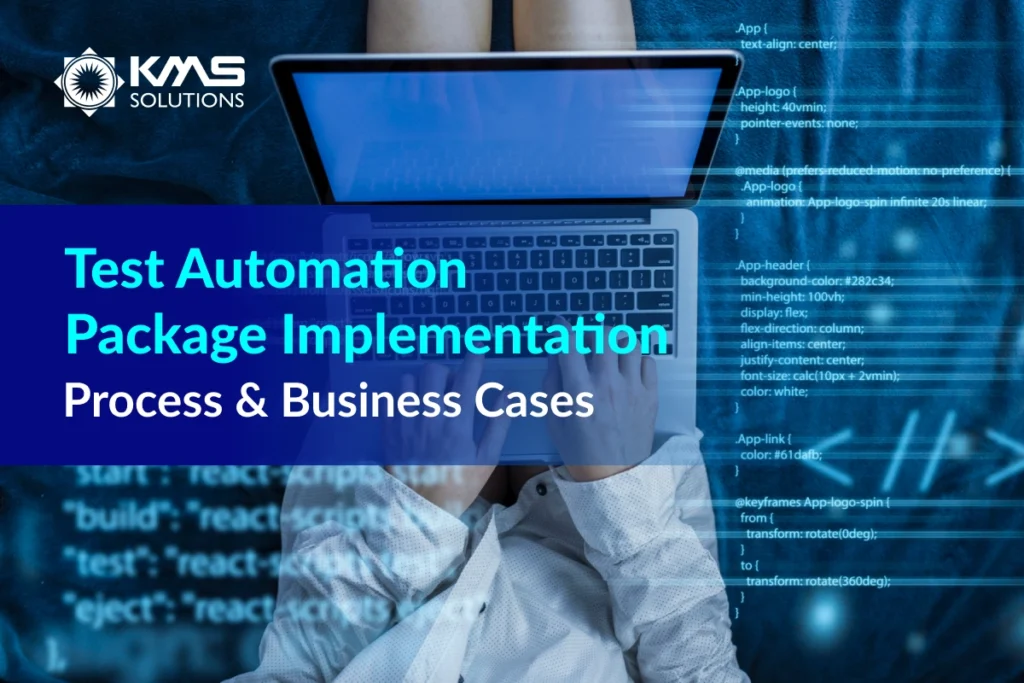In the modern digital landscape, the role of Natural Language Processing (NLP) is redefining the banking and finance landscape. For banks and financial institutions, NLP’s applications range from automating customer support to streamlining regulatory compliance, offering significant potential to improve operational efficiency and accelerate innovation.
By leveraging advanced technologies like NLP, KMS Solutions enables BFSI businesses to enhance operational performance, reduce costs, and meet customer expectations in a rapidly evolving market.
I. What is NLP in the Banking & Finance World?
Natural Language Processing (NLP) is a subfield of artificial intelligence in finance and artificial intelligence in banking, that enables machines to understand, interpret, and respond to human language in a meaningful way. Large Language Models (LLMs), a type of NLP model, also play a significant role in advancing these capabilities. It combines computational linguistics, data science, and machine learning to process and analyze large amounts of text and speech data. NLP allows computers to communicate with humans in their natural languages, making it one of the most crucial technologies for human-computer interaction.

Key Components of NLP:
- Natural Language Understanding (NLU): This aspect focuses on enabling machines to comprehend human language. It involves parsing sentence structure (syntax) and analyzing meaning (semantics) to derive context from text or speech. NLU is used in applications like sentiment analysis and information extraction.
- Natural Language Generation (NLG): This refers to the system’s ability to generate human-like language based on structured data. NLG powers applications like chatbots and automated content creation, allowing systems to respond naturally to human input.
- Speech Recognition: NLP includes speech-to-text systems, which convert spoken language into written text. This is vital for virtual assistants, voice-controlled applications, and automated transcription services.
In recent years, deep learning and transformer-based models such as BERT and GPT have revolutionized NLP, allowing systems to handle complex language tasks with higher accuracy. These models use massive datasets and neural networks to learn context, semantics, and even generate text that resembles human writing.
II. Applications of NLP in the BFSI:
Natural Language Processing (NLP) is widely applied across various industries, driving innovation and improving efficiency in many aspects of our daily lives and business processes. Below are some key applications of NLP, highlighting its impact across sectors, including BFSI:
- Chatbots and Virtual Assistants: NLP powers tools like Siri, Alexa, and customer service bots that understand and respond to user queries, enhancing customer interaction. In the BFSI sector, virtual and voice assistants are employed to provide efficient customer service and handle routine banking queries.
- Machine Translation: Services like Google Translate use NLP to translate text between languages, breaking down communication barriers. Banks and financial institutions leverage machine translation to interact with customers in multiple languages, enhancing accessibility.
- Text Summarization: NLP systems condense large bodies of text into summaries, helping users quickly digest information. By summarizing lengthy financial documents, NLP enables financial institutions to ease the review and decision-making process.
- Loan Application Fraud Detection: NLP helps analyze patterns in loan applications to identify fraudulent behavior, enhancing security and reducing financial risk for banks.
- Document Classification: NLP automates the classification of documents like contracts or forms, saving time and improving accuracy in handling large volumes of paperwork in the financial sector.
- Claims Processing: Insurance companies use NLP to streamline the claims process, extracting relevant data from documents and facilitating faster claims approvals, ultimately improving customer experience.
NLP continues to advance, with significant impacts on automation, customer service, and data analysis, making it a cornerstone of modern AI systems.

III. Key Benefits of NLP in the BFSI Industry
NLP offers numerous advantages for BFSI businesses by leveraging the power of AI to automate processes and provide actionable insights. Here are some of the most impactful benefits:
1. Automating Customer Support and Interaction
One of the most prominent applications of NLP in the BFSI sector is the use of AI-powered chatbots and virtual assistants. These technologies can handle a wide range of customer inquiries—from balance checks and loan applications to fraud detection and insurance claims. NLP enables chatbots to understand and respond to customer questions with natural, conversational language, providing instant and accurate information, 24/7. This not only improves customer satisfaction but also significantly reduces the workload on human customer service agents.
For example, many banks have implemented NLP-driven chatbots that can handle tier-1 customer inquiries, freeing up human agents to focus on more complex issues. This automation leads to faster response times and lower operational costs, as fewer resources are required to manage high volumes of interactions.
2. Enhancing Compliance and Risk Management
In the BFSI industry, maintaining compliance with regulations is both essential and challenging. NLP systems can assist in this by automating document analysis and flagging non-compliance issues in real-time. NLP models can scan vast amounts of legal and financial documents, extracting key information such as regulations, terms, and conditions, and identifying any discrepancies or potential risks.
Moreover, NLP is also widely used in fraud detection. By analyzing patterns in transaction data and communications, NLP systems can identify unusual or suspicious activities, alerting financial institutions to take swift action. This is especially valuable for detecting anomalies in customer behavior that might indicate fraud or money laundering.
3. Streamlining Document Processing
Financial institutions handle a massive volume of paperwork, including loan agreements, insurance claims, and regulatory filings. Manually processing these documents is time-consuming and prone to error. NLP provides a solution by enabling automated data extraction from unstructured documents. For example, NLP systems can extract relevant information (e.g., names, dates, contract terms) from loan applications or insurance forms, significantly reducing processing time and improving accuracy.
This capability also plays a key role in regulatory compliance, as documents can be automatically categorized and flagged for review, ensuring that organizations remain compliant without the need for labor-intensive manual processes.
4. Improving Customer Insights with Sentiment Analysis
Understanding customer sentiment is crucial for BFSI companies aiming to improve your services and maintain a competitive edge. Sentiment analysis, powered by NLP, allows your company to assess customer feedback from various channels (e.g., social media, customer reviews, surveys) and gain insights into public perception of your products and services.
For example, NLP tools can analyze large datasets to identify common issues customers are facing, gauge overall satisfaction, and even predict potential churn. This enables companies to proactively address concerns and refine your offerings based on real-time feedback.

5. Personalizing Financial Services
Personalization is becoming a key differentiator for BFSI companies, and NLP is at the forefront of delivering more tailored services to customers. By analyzing customer communication, transaction histories, and preferences, NLP systems can generate personalized recommendations for financial products, services, or investment opportunities. This level of personalization improves customer engagement and loyalty, as individuals receive relevant, timely suggestions that meet your customers’ specific needs.
For instance, a bank might use NLP to analyze a customer’s financial data and recommend personalized investment opportunities or savings plans based on their spending habits and financial goals.
IV. Approaches to NLP
Natural Language Processing (NLP) utilizes a variety of techniques and models to process and understand human language. Over time, AI software development and NLP has evolved from basic rule-based systems to sophisticated deep learning models, each offering different levels of complexity and capabilities. In the BFSI sector, where precision and accuracy are critical, understanding the different approaches to NLP is essential for selecting the right technology to meet organizational needs.
1. Rules-Based NLP
One of the earliest approaches to NLP, rules-based systems rely on predefined linguistic rules to process language. These systems use basic “if-then” logic to interpret specific commands and respond accordingly. For example, early chatbots used rules-based approaches to answer structured, predictable queries like “What’s my balance?” or “What are your business hours?”
However, rules-based NLP is limited in its ability to scale and adapt to more complex, nuanced language. It works well for simple, repetitive tasks but struggles when faced with ambiguous language or phrases that don’t follow pre-set rules.
2. Statistical NLP
With the advancement of machine learning, statistical NLP became a more flexible alternative to rule-based systems. In statistical NLP, language is modeled using probabilistic methods, where large amounts of text are analyzed to identify patterns and relationships between words and phrases.
For example, part-of-speech tagging—where words in a sentence are labeled according to their grammatical role (e.g., noun, verb, adjective)—relies on statistical models to predict the likelihood that a word belongs to a certain category. This approach is used in many common applications like spellcheck, autocomplete, and text analysis.
Statistical NLP enables systems to handle unstructured data more effectively by identifying word patterns, which is useful in BFSI applications for analyzing customer communications, legal documents, and transaction histories.
3. Deep Learning NLP
Deep learning has significantly transformed NLP in recent years, offering more accurate and complex models. Deep learning NLP models, such as neural networks, allow systems to process and understand vast amounts of language data by mimicking the way the human brain works. These models use multiple layers of algorithms (neurons) to detect intricate patterns in text or speech.
One of the most notable advancements in deep learning NLP is the development of transformer models like BERT (Bidirectional Encoder Representations from Transformers) and GPT (Generative Pre-trained Transformer). These models are capable of understanding context in language by processing entire sentences or paragraphs rather than just individual words.
- BERT: This model has been widely adopted for tasks like question answering, sentiment analysis, and text classification. It is especially effective for understanding context because it processes words in both directions (left-to-right and right-to-left), making it highly accurate in analyzing complex language structures.
- GPT: GPT models are designed for text generation and can predict the next word in a sentence, making them ideal for applications like content generation, chatbots, and automated responses.
In the BFSI sector, deep learning NLP enables more sophisticated applications, such as:
- Automated fraud detection, where systems can analyze patterns in text and transaction data to flag suspicious activities.
- Predictive text generation, which is used in personalized financial advice or in summarizing complex legal documents.

4. Hybrid Approaches
Many modern NLP systems combine elements of rules-based, statistical, and deep learning approaches to maximize accuracy and performance. These hybrid systems can handle a wider range of tasks by leveraging the simplicity of rules-based systems for structured tasks and the flexibility of statistical and deep learning models for more complex language understanding.
For instance, a financial chatbot may use rules-based NLP to respond to common queries quickly and deep learning NLP to handle more nuanced customer requests, such as providing personalized investment advice.
V. Techniques & Models for NLP in the BFSI Sector
NLP is built upon various core tasks that help systems break down, interpret, and generate human language. Each task plays a crucial role in processing raw language data and transforming it into structured, usable information. Here are the key techniques that NLP enables BFSI businesses to process language data effectively:
1. Tokenization
Tokenization is one of the foundational tasks in NLP. It involves breaking down text into smaller units called tokens, which could be words, phrases, or even entire sentences. Tokenization helps NLP models analyze text at a granular level, making it easier to process and understand.
For example, in banking, tokenization helps systems break down a customer’s query (e.g., “What’s my account balance?”) into individual components, allowing the system to understand and respond accurately. It’s also useful for document processing, where contracts or financial records are tokenized for deeper analysis.
2. Part-of-Speech Tagging (POS)
Part-of-speech tagging is the process of labeling each word in a text according to its grammatical role, such as noun, verb, adjective, etc. POS tagging helps in understanding the structure of sentences, enabling the system to grasp the context and meaning more accurately.
In financial services, POS tagging can assist in document classification, such as differentiating between a financial transaction and a legal clause in a contract. It also helps improve the precision of chatbots and virtual assistants by identifying key actions or entities in customer queries.
3. Named Entity Recognition (NER)
Named Entity Recognition (NER) is the task of identifying specific entities within a text, such as names of people, organizations, locations, dates, and monetary values. This is particularly useful for automating processes in the BFSI sector, where identifying specific details is critical for compliance and regulatory purposes.
For instance, in the insurance industry, NER can help extract important information such as policyholder names, claim dates, and payment amounts from unstructured documents, significantly speeding up claim processing. In banking, NER is useful for fraud detection and transaction monitoring, as it can quickly identify unusual entities or transactions.

4. Sentiment Analysis
Sentiment analysis is used to determine the emotional tone of a piece of text, categorizing it as positive, negative, or neutral. In the BFSI sector, sentiment analysis helps banks and financial institutions gauge customer satisfaction or dissatisfaction through their communications, reviews, or feedback on services.
For example, a bank can use sentiment analysis to track customer sentiment from social media posts or feedback forms, helping them understand public perception of their services and products. This insight enables companies to address customer issues more proactively.
5. Coreference Resolution
Coreference resolution refers to the task of identifying when two or more expressions in a text refer to the same entity. This is important for maintaining context throughout a conversation or document, particularly in customer support applications.
In financial systems, coreference resolution helps ensure that communications are accurately interpreted, even when pronouns and references change within a single interaction. This improves the quality of responses from chatbots or virtual assistants.
6. Text Summarization
Text summarization is the process of reducing a large document into a shorter, condensed version while retaining the key information. This task is especially valuable in industries like BFSI, where large volumes of legal and financial documents need to be reviewed.
By using NLP-powered summarization, financial institutions can quickly generate concise summaries of complex documents, such as loan agreements, insurance claims, or compliance reports. This not only speeds up decision-making but also reduces the chances of human error during manual reviews.
7. Machine Translation
Machine translation involves automatically converting text from one language to another. In the global financial landscape, companies often need to operate across multiple regions, making machine translation a valuable tool. It allows institutions to quickly translate financial reports, legal documents, or customer communications into different languages, ensuring smooth cross-border operations.
VI. How NLP Works
Natural Language Processing (NLP) involves several steps that transform raw language data into structured, usable information. Each step plays a crucial role in helping machines understand and generate human language in a meaningful way. For BFSI companies, understanding these processes is key to deploying effective NLP solutions that automate workflows, enhance customer interactions, and improve decision-making.
Here’s a detailed look at how NLP works:
1. Text Preprocessing
Before any analysis can take place, raw text must be cleaned and standardized. This process ensures that the text is in a form that machines can easily interpret and analyze.
- Tokenization: Text is broken down into smaller units, such as words, phrases, or sentences. This allows NLP models to work with manageable data chunks.
- Lowercasing: All characters are converted to lowercase to standardize the text (so “Bank” and “bank” are treated equally).
- Stop Word Removal: Commonly used words like “is,” “the,” and “and” are removed, as they add little meaning to the context.
- Stemming and Lemmatization: Words are reduced to their root forms (e.g., “running” becomes “run”), which helps group similar words for more accurate analysis.
In the BFSI sector, text preprocessing is vital for processing legal documents, customer interactions, and large datasets efficiently.
2. Feature Extraction
Once the text has been preprocessed, the next step is to transform it into a format that machines can understand—usually numerical data.
- Bag of Words (BoW): One of the simplest techniques, BoW creates a matrix that represents word frequencies within a text. Each word in a document is treated as an independent feature, which allows algorithms to analyze text patterns based on word presence.
- TF-IDF (Term Frequency-Inverse Document Frequency): A more advanced version of BoW, TF-IDF not only looks at word frequency but also considers how important a word is by down-weighting words that are common across multiple documents. This helps highlight the most meaningful terms in a document.
- Word Embeddings: More sophisticated models like Word2Vec or GloVe convert words into continuous vectors, capturing their meaning based on context and relationships with other words. This method is commonly used for tasks such as sentiment analysis and predictive text generation.
For BFSI companies, feature extraction allows the analysis of customer reviews, financial reports, and other text-heavy data, making it easier to extract actionable insights from large datasets.
3. Text Analysis
With the text converted into numerical representations, NLP models can now analyze the data to understand meaning, intent, and context. Several techniques come into play at this stage:
- Part-of-Speech Tagging (POS): Each word in a sentence is tagged according to its grammatical role, such as noun, verb, or adjective. This helps in understanding sentence structure, which is critical for generating accurate insights from documents.
- Named Entity Recognition (NER): NER identifies key entities such as names of people, organizations, dates, or monetary amounts within a text. In the BFSI sector, this can be used for tasks like automating compliance checks or extracting details from financial documents.
- Dependency Parsing: This technique maps the relationships between words in a sentence, revealing how they depend on one another grammatically. This is particularly useful for understanding complex contractual or legal language in financial documents.
- Sentiment Analysis: By assessing the emotional tone of a text, sentiment analysis helps businesses gauge customer satisfaction or dissatisfaction based on feedback, reviews, or social media interactions.
4. Model Training
Once the data has been analyzed, machine learning models are trained to recognize patterns and predict outcomes based on the input data. Training involves feeding the model large amounts of text data and adjusting its internal parameters until it can accurately perform specific tasks, such as classifying customer queries or predicting market trends.
For example, a BFSI company may train an NLP model on historical customer service data to improve chatbot responses. These models can also be fine-tuned over time to become more accurate as they encounter new data.

5. Evaluation and Fine-Tuning
After the model has been trained, it’s evaluated for accuracy and performance. This involves testing the model on new, unseen data to ensure it can generalize its predictions effectively. Based on the results, the model may be fine-tuned to improve its performance.
In BFSI, fine-tuning NLP models ensures that systems are up-to-date with evolving language patterns, customer behaviors, and regulatory changes. Regular evaluation helps maintain the accuracy of chatbots, fraud detection systems, and document automation processes.
Read more: Guide for Technical Lead to Develop AI-Powered Software
VI. Challenges Faced by BFSI Companies in Implementing NLP
In the BFSI sector, Natural Language Processing (NLP) offers significant benefits, such as improved customer service and process automation. However, implementing NLP poses several obstacles. Here are key challenges that banks and financial institutions may face during the process of adopting NLP:
- Shortage of NLP Expertise: NLP is a specialized domain within AI, requiring advanced knowledge of linguistics and deep learning models. However, there is a significant gap in the availability of professionals with these skills, particularly those with a deep understanding of financial data and industry regulations. Besides, banks and financial institutions face difficulties in recruiting or training in-house talent, which can lead to delays, suboptimal NLP implementations, or incomplete projects.
- Integration with Legacy Systems: Many BFSI companies still depend on legacy IT systems, which makes integrating new NLP technologies challenging. Without adequate expertise to support the integration, institutions often encounter technical issues, data incompatibilities, and disruptions to their workflow, further complicating the adoption of new technologies.

- Data Privacy and Regulatory Compliance: The BFSI sector is governed by stringent regulatory standards. Implementing NLP solutions without fully understanding data privacy and compliance requirements could result in regulatory violations, leading to fines, reputational damage, and loss of customer trust.
- High Costs and Uncertain ROI: Developing and deploying NLP solutions can be a costly endeavor, especially given the scarcity of skilled experts. For many BFSI companies, the high investment costs are hard to justify without a clear understanding of the potential return on investment (ROI), making decision-makers hesitant to commit to large-scale NLP projects.
VII. Implementing NLP Effectively with the Helps from KMS Solutions:
KMS Solutions has a dedicated team of data scientists and NLP experts who are well-versed in the latest AI technologies and financial industry trends. By partnering with KMS, BFSI companies can tap into a pool of specialized NLP expertise, accelerating project timelines and ensuring that solutions are tailored to their unique needs and challenges.
We also offer customized NLP solutions designed to address specific pain points in the BFSI sector, ensuring clients can extract maximum value from their investments.
Having extensive experience in modernizing and integrating NLP systems with legacy banking and financial infrastructure, our experts ensure smooth data migration and system interoperability, minimizing disruptions and improving overall efficiency.
Additionally, we incorporate security and privacy features into our solutions to handle sensitive financial data while adhering to industry standards. This helps BFSI companies avoid legal and compliance risks, ensuring that NLP-driven customer interactions and data processes are both effective and secure. We also offer RPA Robotic Process Automation to help BFSI companies streamline their workflows and reduce manual labor.
VIII. Take the Next Step with KMS Solutions
Natural Language Processing (NLP) is transforming the BFSI sector by automating customer service, enhancing fraud detection, and streamlining regulatory compliance. Through AI-driven chatbots, sentiment analysis, and document automation, NLP helps financial institutions improve efficiency, reduce operational costs, and provide more personalized customer experiences.
As BFSI companies continue to adopt NLP, the technology enables faster, more accurate decision-making and improved customer engagement. KMS Solutions, with our deep expertise in NLP and automation, helps BFSI institutions harness these technologies to drive innovation and optimize operations, ensuring a competitive edge in the digital landscape.











